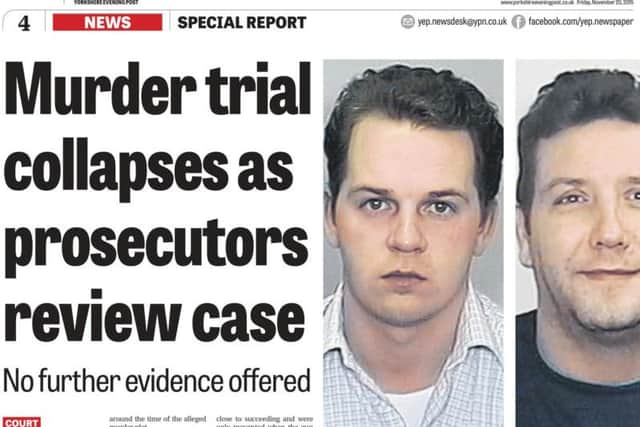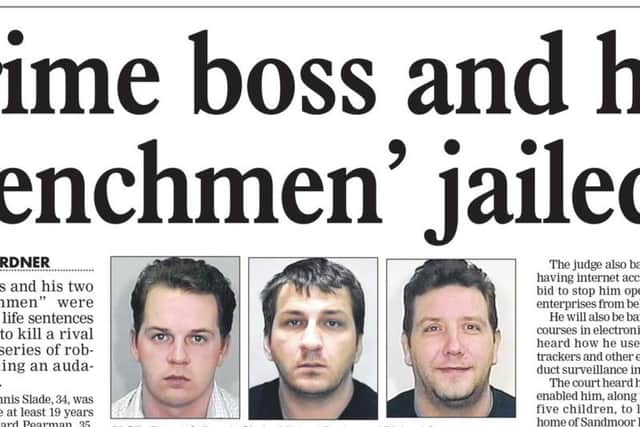Leeds gangster Dennis Slade - what did he do and why did murder plot case collapse?
and live on Freeview channel 276
The Slade gang robbery case was “right up there” with some of the biggest investigations ever mounted by West Yorkshire Police.
Trials were held at Leeds Crown Court amid a massive security operation thought to have cost millions of pounds


Advertisement
Hide AdAdvertisement
Hide AdSlade travelled daily between Wakefield's maximum security prison and the court in an armoured van surrounded by cars and motorcycles and surveyed from above by a police helicopter.
The cavalcade took different routes each day, and motorcycle officers held up traffic to allow it to sweep past, causing disruption and leaving passers-by wondering what was going on.
Once Slade was inside the courts complex, armed police were positioned at the doors of the trial courtroom and elsewhere in the building.
Metal detectors were also erected outside the courtroom.


The tight security was ordered because Slade had escaped from custody in 1992 as a teenager.
Advertisement
Hide AdAdvertisement
Hide AdA West Yorkshire Police spokesman confirmed that the Slade investigation was "right up there" alongside the force's largest cases of the last 20 years.
Offences in the robbery trial included:
SECURITAS ROBBERY - March 8, 2006
The Slade gang got away with more than a million pounds in a successful and dramatic raid on a security van after it was rammed at the rear with a tractor.
The crew of the Securitas van were travelling from Merseyside to their depot near Warrington on March 8, 2006 when the robbers struck.
After leaving the M6 the two crew on board pulled up at a give way junction behind a Volvo flatback low-loader lorry unaware that they had driven into a trap.
Advertisement
Hide AdAdvertisement
Hide AdWith the loader preventing them moving forward, the van was suddenly rammed from behind, the loader arms attached to a tractor slamming into the rear door and allowed partial access.
The van was carrying 1.4m and the robbers managed to get just over 1m out before fleeing in a stolen car.About a mile away a witness saw men moving bags from a Volvo car into an Audi estate.
Attempts were made to burn out the Volvo but they were only partially successful. It had been stolen 10 months earlier in Leeds and in the period in between had done only 300 miles.
The gang often stole high-powered vehicles which they kept in convenient premises for use in raids when needed.
Advertisement
Hide AdAdvertisement
Hide AdThe loader and the tractor, which were abandoned at the scene, had both been stolen to order from Wilberfoss, near York, especially for the robbery.
The tractor had only been delivered at 4.30pm the day before the Securitas robbery, but within five hours of its arrival it and the loader had both been stolen. They were not spotted again until they appeared during the robbery.
The raid demonstrated the kind of detailed planning undertaken by the gang because the width of the arms on the tractor taken, which usually had a bucket or some other attachment, corresponded exactly with the width of the door which was repeatedly rammed on the security van.
SAINSBURY'S PLOT - Colton Retail Park, January 29, 2008
An audacious plan to carry out a half-million-pound robbery at a West Yorkshire supermarket was foiled when a member of staff heard drilling.
Advertisement
Hide AdAdvertisement
Hide AdIt was about 9pm on January 29, 2008, that a manager went to clear some paperwork in the security area at Sainsbury's at the Colton Retail Park in Leeds near junction 46 of the M1.
In that area, in addition to the supermarket safes, was a purpose-built room behind the cash machines where money would be delivered for staff to refill them.
While there she suddenly heard drilling and then, as she went to check, the sound of footsteps in the roof space above her head.
Fearing for her safety, she immediately contacted the police. When officers arrived those responsible had fled but the police found damage to the roof and abandoned equipment including a set of ladders.
Advertisement
Hide AdAdvertisement
Hide AdThe damage allowed access through the roof to an electrical room, below which work had begun to weaken the wall into the secure cashroom.
It was clear the raiders intended to force entry when staff received cash to reload the ATMs.
Unknown to those officers who first arrived at the scene, those behind the plot were already the subject of an extensive and long- standing police investigation.
Slade and some of his closest associates had been under surveillance by a team of undercover officers for months and a white Toyota van regularly used by the gang was often seen near the store in previous weeks.
Advertisement
Hide AdAdvertisement
Hide AdThe undercover operation showed how the gang frequently scouted out other targets across West and North Yorkshire in the months before they were arrested.
On one day alone, January 10, 2008, a covert tracking device in the Toyota van showed it visited Brighouse, Huddersfield, Elland, Halifax and a number of roads with Post Offices in Bradford.
That afternoon the van continued to Bingley, Keighley, Ilkley, Otley, Wetherby, Boston Spa, back to Wetherby and on to Thirsk and Boroughbridge before returning to Boston Spa, parking up near the Post Office.
The van then went back to Sainsbury's in Moortown, Leeds, before going near an industrial estate where a depot was sited with a cash-handling operation for two high street banks.
Advertisement
Hide AdAdvertisement
Hide AdThe final destination before the vehicle was parked up was the Loomis, formerly Securitas, cash-handling centre off St Hilda's Road, Leeds.
SMASH AND GRAB - Cross Gates Post Office, December 12, 2007
One minute staff at a Post Office in Leeds were working normally, the next they were facing a pile of rubble as robbers ram-raided a hole through the wall from the street using a heavy digger.
Seconds earlier, the assistant branch manager at Cross Gates Post Office, had been using a computer inches away from where the robbers crashed in.
If she had not moved she might not have lived to tell the tale, Leeds Crown Court heard.
Advertisement
Hide AdAdvertisement
Hide AdEight members of staff were doing a stock take after the doors were locked when the ruthless robbers struck on December 12, 2007.
A witness watched in amazement as the driver of a red digger accelerated from the opposite side of the road, its telescopic arm hitting the wall and breaching it.
He then saw the driver jump out and scramble over the rubble shouting "Give us the money" and a second man followed.
The assistant manager heard what she thought was an explosion and hurried back into the main Post Office. As she did a man all in black with a scarf around his face was standing on her desk.
Advertisement
Hide AdAdvertisement
Hide AdHe shouted to her to get on the floor, threatening to kill her.
The raiders took two security boxes containing only stamps and missed £50,000 in the main safe.
The pair fled in a stolen Ford Focus which was later hidden in a garage in Moortown, Leeds, rented by an associate of Dennis Slade. It had been stolen from the owner's drive in Cottingley, Leeds, only five days earlier.
The heavy equipment used was stolen to order.
The telescopic loader was taken earlier that day from a building site at Sandmoor Drive, round the corner from Slade's home.
Advertisement
Hide AdAdvertisement
Hide AdWhy the murder plot conviction against Dennis Slade, Richard Pearman and Michael Baxter collapsed.
A murder conspiracy re-trial Dennis Slade, Richard Pearman and Michael Baxter collapsed in 2015 when prosecutors took the decision not to offer further evidence against them.
All three men were given life in 2010 after being found guilty of a series of robbery offences and conspiracy to murder following trials in 2009 and 2010.
The murder conspiracy conviction was quashed and a re-trial was ordered to take place.
Advertisement
Hide AdAdvertisement
Hide AdThe jury at the re-trial at Sheffield Crown Court was directed to return not guilty verdicts against all three defendants after the prosecution discontinued the case just a week into the hearing, which had been expected to last around six weeks.
Slade, Pearman and Baxter were then returned to custody to serve significantly reduced minimum jail terms.
Prosecutor Paul Greaney, QC, told Mr Justice Globe: “The prosecution has an obligation to review all cases, indeed, the code for Crown prosecutors, which guides our decision making, provides ‘review is a continuing process and prosecutors must take account of any changes in circumstances that occurs as the case develops, including what becomes known of the defence case.’
“We have conducted such a review in this case and have concluded that there is no longer a realistic prospect of conviction. Accordingly, we offer no further evidence.”
Advertisement
Hide AdAdvertisement
Hide AdAll three defendants were also cleared of criminal damage, arson and handling stolen goods.
Slade’s minimum term was reduced from 19 years to 10 years.
Pearman and Baxter had their 17-year minimum sentences reduced to nine and eight and a half years respectively.
Slade, Pearman and Baxter were accused of plotting to kill a rival by arranging for “assassins” to shoot him dead in the East End Park area of the city.
It was alleged Slade, Pearman and Baxter and their “confederates” used vehicles to carry out surveillance on their intended victim and possessed a shotgun and ammunition in order to carry out the shooting in February and March 2008.
Advertisement
Hide AdAdvertisement
Hide AdBut jurors were told the defendants were likely to claim their activities over the period of the alleged conspiracy to murder might be explicable on the basis of plans for further robberies.
After the case, a joint statement by West Yorkshire Police and the Crown Prosecution Service said: “Throughout the course of any criminal investigation, it is the responsibility of the Police and CPS to review the evidence available to them.
“In conjunction with CPS a decision has been taken in this case that there was insufficient evidence for a realistic prospect of conviction.”
Jurors at the re-trial had been told of changes to the way the prosecution intended to present the case over bugging evidence.
Advertisement
Hide AdAdvertisement
Hide AdUnbeknown to Slade, Pearman and Baxter, officers from West Yorkshire Police and the Serious Organised Crime Agency were investigating them around the time of the alleged murder plot.
The police operation had been going on for some time beforehand and investigators used surveillance techniques to monitor the location of one of their vehicles - an Audi RS6.
They also listened to and recorded conversations occurring within it.
Officers were able to establish that a shooting was planned.
Advertisement
Hide AdAdvertisement
Hide AdThe prosecution even claimed that on one occasion the alleged gunmen came very close to succeeding and were only prevented when the gun jammed at the critical moment.
All three men were tried and convicted for conspiracy to murder and other charges in 2009.
At that trial, the prosecution alleged that the voices heard within the Audi RS6 were Pearman, Baxter and, on occasion, Dennis Slade.
The defendants appealed their convictions.
The convictions were quashed and a retrial ordered.
At the start of the re-trial Mr Greaney told jurors: “At this trial the prosecution do not allege that the defendants were in the Audi RS6, but we argue that the circumstances nonetheless provide a compelling case that the defendants were acting in concert with those who were.”